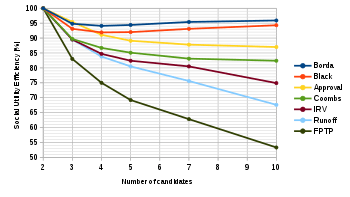Social utility efficiency
Social utility efficiency (SUE) is a measurement of the utilitarian performance of voting methods—how likely they are to elect the candidate who best represents the voters' preferences.[2]

It is also known as Voter Satisfaction Index (VSI)[3] or Voter Satisfaction Efficiency (VSE).[4] Bayesian Regret measures the same property, but inverted and non-normalized.[3][5][6][7][8]
Social utility efficiency is defined as the ratio between the social utility of the candidate who is elected by a given voting method and that of the candidate who maximizes social utility, where is the expected value over many iterations:[9]
A voting method with 100% efficiency would always pick the candidate that maximizes voter utility. A method that chooses a winner randomly would have efficiency of 0%, and a (pathological) method that did worse than a random pick would have less than 0% efficiency.
SUE is not only affected by the voting method, but is a function of the number of voters, number of candidates, and of any strategies used by the voters.[1]
The concept was originally introduced as a system's "effectiveness" by Weber in 1977,[2] using a random society (impartial culture) model, but it has since been extended to the more realistic spatial model of voting[1] and a hierarchical clusters model.[4]
See also
References
- Merrill, Samuel (1984). "A Comparison of Efficiency of Multicandidate Electoral Systems". American Journal of Political Science. 28 (1): 23–48. doi:10.2307/2110786. ISSN 0092-5853. JSTOR 2110786.
- Weber, Robert J. (September 1978). "Comparison of Public Choice Systems". Cowles Foundation Discussion Papers. Cowles Foundation for Research in Economics. No. 498.
- Shentrup, Clay (2007-07-07). "Voter Satisfaction Index". Center for Range Voting. Retrieved 2019-07-24.
Voter satisfaction index, or "VSI" for short (also called "social utility efficiency" ... a lower number is actually better, and this can confuse people who are new to the concept. ... the utility units have an arbitrary magnitude, making it difficult to compare Bayesian regret figures
- Quinn, Jameson (2017-02-10). "Voter Satisfaction Efficiency FAQ". GitHub Pages. Retrieved 2019-07-24.
- Quinn, Jameson. "Answer to 'How should you judge the quality of a voting system?'". Quora. Retrieved 2019-07-24.
The simulation method, originally called "Bayesian Regret" by Warren Smith in his systematic exploration of this question, and more recently re-christened as "Voter Satisfaction Efficiency" (VSE)
- Quinn, Jameson (2018-04-12). "A voting theory primer for rationalists". LessWrong. Retrieved 2019-07-24.
- Hansen, Jeremy A (2014). "Comparing Approval At-Large to Plurality At-Large in Multi-Member Districts". Conference: Fifth International Workshop on Computational Social Choice.
- "Range voting with mixtures of honest and strategic voters". RangeVoting.org. Retrieved 2019-07-26.
SociallyBest 0 ... RandomWinner 1 ... SociallyWorst 2.0024
- Merrill, Samuel (2014-07-14). Making Multicandidate Elections More Democratic. Princeton University Press. ISBN 9781400859504.